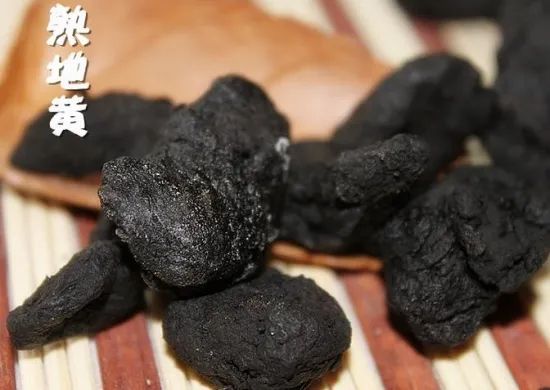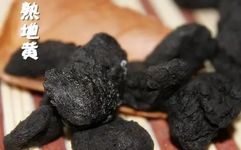Sharing Health Knowledge provides you with health information
Click below to follow for free↓↓↓
Rehmannia glutinosa (Shu Di Huang) is the root of the plant from the family Scrophulariaceae, specifically the Rehmannia or Huaiqing Rehmannia. The processing methods are recorded in the “Classic of Difficulties”. It is mainly produced in Henan and Zhejiang provinces of China, and is used in medicine after steaming and drying. It can be used for symptoms such as blood deficiency, dizziness, palpitations, irregular menstruation, excessive bleeding, liver and kidney yin deficiency, night sweats, seminal emission, infertility, lower back and knee weakness, tinnitus, blurred vision, premature graying of hair, diabetes, constipation, and kidney deficiency with shortness of breath. Let’s explore the efficacy and uses of Rehmannia glutinosa and its proper consumption methods!

The Efficacy and Uses of Rehmannia Glutinosa
1. Blood Supplementation: Rehmannia glutinosa is sweet and slightly warm, and it belongs to the liver and kidney meridians. It is generally used to nourish yin and benefit essence, serving as a blood tonic. It is often used in combination with Angelica sinensis (Dang Gui), Ligusticum chuanxiong (Chuan Xiong), and Paeonia lactiflora (Bai Shao) to assist with blood deficiency, palpitations, dizziness, insomnia, and irregular menstruation. When combined with Ziziphus jujuba (Suan Zao Ren), it can help calm the mind in cases of blood deficiency. For excessive bleeding, it can be taken with Ejiao (Donkey-hide Gelatin) and Artemisia argyi (Ai Ye) to replenish blood.
2. Kidney Supplementation: Rehmannia glutinosa is also very effective for kidney supplementation. It is one of the main ingredients in the Six-Ingredient Rehmannia Pill (Liu Wei Di Huang Wan), which is said to “greatly nourish the true yin of the five organs”. When combined with Dioscorea opposita (Shan Yao) and Cornus officinalis (Shan Zhu Yu), it can assist with liver and kidney yin deficiency, lower back and knee weakness, and night sweats. When taken with Anemarrhena asphodeloides (Zhi Mu) and Phellodendron amurense (Huang Bai), it is effective for patients with yin deficiency and bone steaming heat. Additionally, when combined with Polygonum multiflorum (He Shou Wu), it can address issues of blood deficiency and premature graying of hair.
3. Heat Clearing: When used together with raw Rehmannia (Sheng Di), it can both nourish and clear heat, being particularly effective for symptoms that exhibit both yin blood deficiency and heat signs. People often use Rehmannia glutinosa in soups to impart a subtle flavor, nourishing the marrow. It is also used to infuse alcohol, with different herbs added based on specific needs, which has excellent health benefits.
Proper Consumption Methods of Rehmannia Glutinosa
1. Rehmannia Glutinosa Stewed Chicken
Stewed chicken with Rehmannia glutinosa is a common way to consume it. To prepare, you need one black chicken and 25 grams of Rehmannia glutinosa, along with 15 grams of Angelica sinensis (Dang Gui) and appropriate amounts of Paeonia lactiflora (Bai Shao) and Ligusticum chuanxiong (Chuan Xiong). Clean all the prepared herbs and place them in a clean cloth bag, tying it securely. After cleaning the black chicken, place it directly in a stewing pot, add enough water, and include ginger and scallions, along with the herb bag. After bringing it to a boil, simmer on medium heat for about two hours, and finally season with salt.
2. Rehmannia Glutinosa Porridge
Rehmannia glutinosa is also particularly suitable for making porridge. When cooking porridge with Rehmannia glutinosa, prepare 15 grams of Rehmannia glutinosa, 50 grams of rice, and an appropriate amount of rock sugar. Slice the prepared Rehmannia glutinosa and boil it with an appropriate amount of water. After boiling, simmer on low heat for half an hour. After cooking, strain out the herb residue to obtain the medicinal liquid, then return it to the pot, add the washed rice and rock sugar, and cook into porridge, which can be consumed once ready.
3. Rehmannia Glutinosa Infused Alcohol
Infusing alcohol is also a common method of consuming Rehmannia glutinosa. When needed, prepare 50 grams of Rehmannia glutinosa, 20 grams of Goji berries (Gou Qi Zi), and 15 grams of Angelica sinensis (Dang Gui). Place them together in a clean glass bottle, add high-purity liquor, and seal it for infusion. The infused medicinal alcohol can be taken directly, with a daily dosage not exceeding 20 grams. Consistent consumption of this medicinal alcohol will significantly improve physical health and reduce the incidence of rheumatic bone pain.
Health Knowledge Sharing provides you with health information
Click below to follow for free↓↓↓
Note:Some text and image resources in this article are sourced from the internet. The purpose of reprinting this article is to convey more information. If there are any errors in source attribution or infringement of your legal rights, please leave a message in the background to notify us. If the situation is verified, we will delete it immediately and apologize to you.
Previous Reviews
-
The Side Effects of Sanqi Powder: Eating Sanqi This Way Can Be Dangerous!
-
As a pure Chinese herbal preparation, who is Huang Qi Essence generally suitable for?
-
Doctor’s Advice: Huang Qi’s “First Nemesis”, pairing it with these two can make cancer cells “sneakily active”

